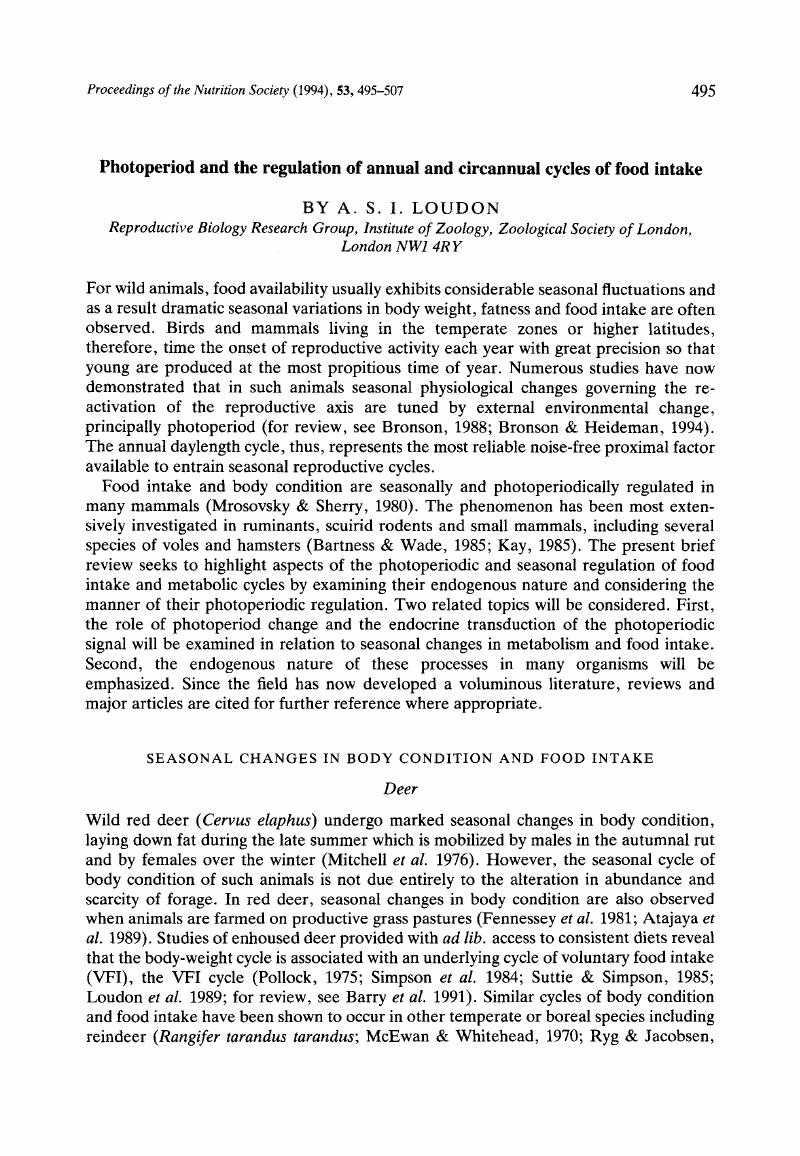Crossref Citations
This article has been cited by the following publications. This list is generated based on data provided by Crossref.
Tveiten, H.
Johnsen, H. K.
and
Jobling, M.
1996.
Influence of maturity status on the annual cycles of feeding and growth in Arctic charr reared at constant temperature.
Journal of Fish Biology,
Vol. 48,
Issue. 5,
p.
910.
Mercer, Julian G
1998.
Regulation of appetite and body weight in seasonal mammals.
Comparative Biochemistry and Physiology Part C: Pharmacology, Toxicology and Endocrinology,
Vol. 119,
Issue. 3,
p.
295.
WallisDeVries, Michiel F.
1998.
Grazing and Conservation Management.
p.
275.
Mangels, Robert A
Powers, J.Bradley
and
Blaustein, Jeffrey D
1998.
Effect of photoperiod on neural estrogen and progestin receptor immunoreactivity in female Syrian hamsters.
Brain Research,
Vol. 796,
Issue. 1-2,
p.
63.
Webster, J. R.
Corson, I. D.
Littlejohn, R. P.
Stuart, S. K.
and
Suttie, J. M.
1998.
Photoperiodic requirements for rapid growth in young male red deer.
Animal Science,
Vol. 67,
Issue. 2,
p.
363.
Génin, F
and
Perret, M
2000.
Photoperiod-induced changes in energy balance in gray mouse lemurs.
Physiology & Behavior,
Vol. 71,
Issue. 3-4,
p.
315.
Atcha, Zeenat
Cagampang, Felino Ramon A.
Stirland, J. Anne
Morris, Ian D.
Brooks, A. Nigel
Ebling, Francis J. P.
Klingenspor, Martin
and
Loudon, Andrew S. I.
2000.
Leptin Acts on Metabolism in a Photoperiod-Dependent Manner, But Has No Effect on Reproductive Function in the Seasonally Breeding Siberian Hamster (Phodopus sungorus)**This work was supported by a research grant awarded to A.S.I.L. and FRAC by the Biotechnology and Biological Sciences Research Council (United Kingdom) and a Biotechnology and Biological Sciences Research Council-supported Ph.D. studentship (to Z.A.) also supported in part by AstraZeneca Central Toxicology Laboratory (Cheshire, UK)..
Endocrinology,
Vol. 141,
Issue. 11,
p.
4128.
Webster, J. R.
Corson, I. D.
Littlejohn, R. P.
Martin, S. K.
and
Suttie, J. M.
2001.
The rôles of photoperiod and nutrition in the seasonal increases in growth and insulin-like growth factor-1 secretion in male red deer.
Animal Science,
Vol. 73,
Issue. 2,
p.
305.
Gorman, Michael R.
Goldman, Bruce D.
and
Zucker, Irving
2001.
Handbook of Behavioral Neurobiology.
Vol. 12,
Issue. ,
p.
481.
Zhou, Shaoyuan
Cagampang, Felino R. A.
Stirland, J. Anne
Loudon, Andrew S. I.
and
Hopkins, Stephen J.
2002.
Different Photoperiods Affect Proliferation of Lymphocytes but Not Expression of Cellular, Humoral, or Innate Immunity in Hamsters.
Journal of Biological Rhythms,
Vol. 17,
Issue. 5,
p.
392.
Prendergast, Brian J.
Nelson, Randy J.
and
Zucker, Irving
2002.
Hormones, Brain and Behavior.
p.
93.
Thiéry, J.C
Chemineau, P
Hernandez, X
Migaud, M
and
Malpaux, B
2002.
Neuroendocrine interactions and seasonality.
Domestic Animal Endocrinology,
Vol. 23,
Issue. 1-2,
p.
87.
Clarke, Iain J.
Rao, Alexandra
Chilliard, Yves
Delavaud, Carole
and
Lincoln, Gerald A.
2003.
Photoperiod effects on gene expression for hypothalamic appetite-regulating peptides and food intake in the ram.
American Journal of Physiology-Regulatory, Integrative and Comparative Physiology,
Vol. 284,
Issue. 1,
p.
R101.
Mauget, Christiane
Mauget, Robert
and
Sempéré, Antoine
2003.
Metabolic cost of first reproduction in young female European roe deerCapreolus capreolus.
Acta Theriologica,
Vol. 48,
Issue. 2,
p.
197.
Rousseau, K.
Atcha, Z.
and
Loudon, A. S. I.
2003.
Leptin and Seasonal Mammals.
Journal of Neuroendocrinology,
Vol. 15,
Issue. 4,
p.
409.
Wikelski, Martin
Martin, Lynn B
Scheuerlein, Alex
Robinson, Maisha T
Robinson, Nuriya D
Helm, Barbara
Hau, Michaela
and
Gwinner, Eberhard
2008.
Avian circannual clocks: adaptive significance and possible involvement of energy turnover in their proximate control.
Philosophical Transactions of the Royal Society B: Biological Sciences,
Vol. 363,
Issue. 1490,
p.
411.
Grovenburg, T. W.
Jenks, J. A.
Klaver, R. W.
Swanson, C. C.
Jacques, C. N.
and
Todey, D.
2009.
Seasonal movements and home ranges of white-tailed deer in north-central South Dakota.
Canadian Journal of Zoology,
Vol. 87,
Issue. 10,
p.
876.
Siikavuopio, Sten Ivar
Sæther, Bjørn-Steinar
Skybakmoen, Steinar
Uhlig, Christian
and
Haugland, Espen
2009.
Effects of a simulated short winter period on growth in wild caught Arctic charr (Salvelinus alpinus L.) held in culture.
Aquaculture,
Vol. 287,
Issue. 3-4,
p.
431.
Eriksson, Lars-Ove
Alanärä, Anders
Nilsson, Jan
and
Brännäs, Eva
2010.
The Arctic charr story: development of subarctic freshwater fish farming in Sweden.
Hydrobiologia,
Vol. 650,
Issue. 1,
p.
265.
Siikavuopio, Sten I.
Knudsen, Rune
Amundsen, Per-Arne
and
Saether, Bjørn Steinar
2012.
Growth performance of European whitefish [Coregonus lavaretus(L.)] under a constant light and temperature regime.
Aquaculture Research,
Vol. 43,
Issue. 11,
p.
1592.





